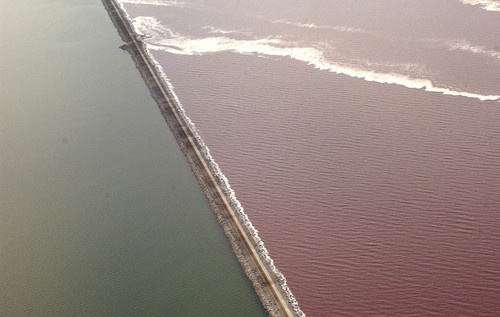This is an archived article that was published on sltrib.com in 2013, and information in the article may be outdated. It is provided only for personal research purposes and may not be reprinted.
State and federal authorities are poised to issue draft permits to Union Pacific Railroad (UP) to "temporarily" close the remaining culvert on its rock-fill causeway across the Great Salt Lake, sealing the final mixing point between the lake and its high-salinity North Arm.
The 20-mile single-track causeway, a vital shortcut between Ogden and the west coast, has been sinking into the lakebed for years, rendering its two major culverts unstable. The culvert closest to the west shore was filled last year while UP developed plans for a 180-foot-long bridge. This structure would span a new breach designed to replace the mixing function played by the culverts.
In late October the company, which sends 14 trains a day across the lake, sought emergency permission from the U.S. Army Corps of Engineers to fill the remaining east culvert, even though UP has yet to design a permanent fix.
"This culvert is deteriorating faster than we imagined it would," railroad spokesman Mark Davis said. "It's getting to the point where it would be unsafe to runs trains over it and we would have to detour traffic through Salt Lake City."
But the culvert situation could be putting transport safety at odds with the ecological health of the lake, which supports crucial resting and nesting spots for migratory birds and $1.3 billion in economic activity.
The project is of acute interest to not just environmentalists, but also the $100 million brine shrimp business and a $200 million minerals industry, which could face serious disruptions should the lake's salinity levels fluctuate.
Regulators agree the culvert closure cannot wait, but they want UP to keep a close watch on the lake to see what happens. The Army Corps last week authorized the closure, contingent upon state water-quality certification, according to Jason Gipson of the agency's Utah regulatory office.
The Utah Division of Water Quality expects to issue a draft certification Friday. But officials anticipate issuing a final permit at the close of business Monday after just four days for public comment, according to division director Walt Baker, although the division will continue accepting comment.
"With construction of the bridge we have to make sure the fragile balance between North and South arms is not disrupted," Baker said. "That modeling and monitoring will help determine that and help with the design of the bridge."
The railroad expects to close the causeway and begin filling the east culvert as early as Tuesday. A monitoring program is already in the works.
"We are bringing on a group that will help us understand the replacement for back and forth flow, to keep us in tune with salt exchange and reservoirs on both sides," Davis said.
Still, regulators insist UP commit to mitigation steps should salinity levels swing too far in response to the culvert closure. This could mean breaching the causeway, Gipson said.
This rock runway, which isolated the lake's North Arm, was built in 1959 to replace the wooden trestle known as the Lucin Cutoff. The massive bay formed by Promontory Point and the west shore soon became saturated with salt.
Infused with freshwater from three rivers spilling out of mountains to the east, the main part of the lake is much less salty and slightly higher in surface elevation. The culverts were cut in later, not to promote mixing, but to allow boat traffic between the two arms, according to Davis.
These structures came to account for about half of the mixing between the two arms. Twenty-year-old data indicated more than half the mixing came from lakewater passing through the permeable causeway itself, but circumstances are now much different, according to Gipson.
"It's been impacted by years of train traffic. We believe those pore spaces [between the rocks] are smaller so we speculate there is less transmission [through the causeway]," he said.



